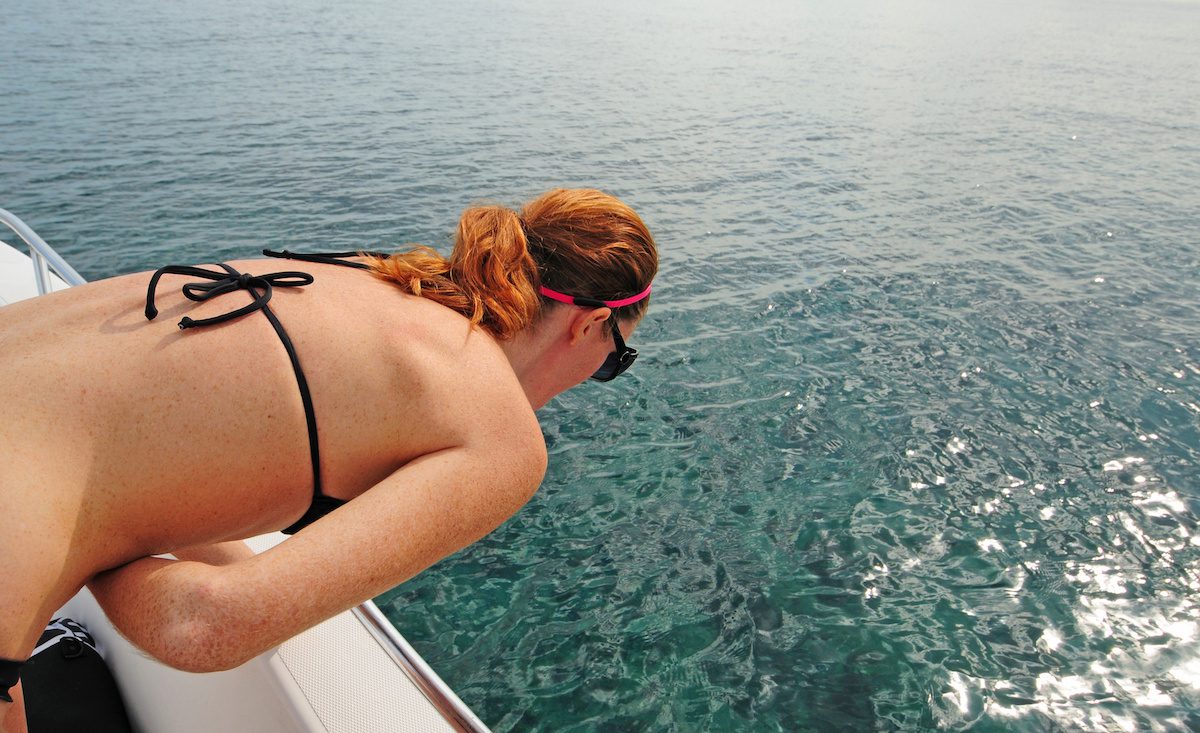What is the definition of misery?
Answer: Seasickness
One of the first questions I get asked when a landlubber finds out I work at sea is, “Do you get seasick?” In truth, I have, just once.
I was cooking lasagna in the galley of a 37-foot sailboat racing upwind in 20-foot swells when the kerosene lamp broke. Taken separately, the confined space, heavy rolls, the smell of lasagna and kerosene never bothered me much, but the combination of all four proved insurmountable. Luckily I just went topside and waited for the cabin to air out but the 60 seconds it took me to escape were pure misery.
The single worst aspect of sea sickness is not being able to stop it. Seasickness on a boat close to shore can be solved by returning to the dock but, in the middle of the ocean, your only option is to wait until the seas calm down. This can take days.
So what can you do if you are looking to start a career at sea (or just looking forward to your first cruise ship adventure), but find yourself feeling queasy each time you step into a boat?
The good news is that 75% of people eventually get acclimated to the sea and are naturally cured of the affliction. For the other 25% of you…. find a new career! Seriously, I’ve seen seasick people and it looks miserable, truly miserable.
For those determined to stick it out, here’s our list of 50 ways to prevent seasickness. Some of these are scientifically tested, others from sea stories, and most we collected from the men and women working at sea. Results will vary, a solution that works for one person often doesn’t work for another, so you will need to take a scientific approach to find a solution that works for you.
- Fool Yourself – Believe it or not, 99% of seasickness is mental. Even the most stalwart mariner feel queazy at times… but we quickly solve the problem by telling ourselves “I don’t get seasick!”. Repeat it 3 times in the mirror before departure. And make sure you say it with conviction! Avoid asking yourself and those around you “How am I feeling” too often.
- Look at the Horizon – When a ship is riding through a heavy sea everything is moving. The only thing that is stationary is the horizon and looking at it will often reset your internal equilibrium.
- Follow your nose – Motion sickness is often caused by bad smells. Even pleasant smells, like a girlfriend’s perfume, can often send you for the railings. So if you smell anything strange, move into fresh air fast. And be sure to keep your living area clean… a dirty room or body is a quick way to invite odor.
- Other people – Motion sickness is highly contagious! One sure-fire way to get seasick is to watch other people getting sick. Like a schoolyard cold, motion sickness is very contagious. Avoid other seasick people at all costs.
- Watch what you eat – One of the reasons people get seasick on cruise ships is that we tend to over-eat. When the waves hit greasy, high-fat foods swirl around your stomach like water in the head. Also, avoid sugar which can make you light-headed and dizzy.
- Chew gum and eat sweets – Hey didn’t I just say to avoid sugar? Yes but some people swear by it, others think just the repetitive motion of chewing, most effective with gum (ginger gum or candy works best), helps relieve symptoms.
- No booze – Alcohol can make you seasick on dry land, the effects are worse in open ocean so avoid drinking at all costs.
- Eat Only Saltines – An old sailor’s myth is, when the seas get rough, eat only saltines. Personally, I think a full and healthy diet helps prevent seasickness but others swear by eating just saltines.
- Drink Only Lime Juice – Like the saltines, some old salts swear by drinking only lime juice in a storm claiming it helps contract your stomach. We think this is bogus but, if you are going to try it, be sure to avoid all dairy because the mixture of lime and cheese might be a great flavor for a Dorito but, in real life, they create curds in your stomach. Ouch!
- Ginger – Whether you chew it, suck on it or dilute it in tea ginger has long been a favorite home remedy for motion sickness. Give it a try and, if you believe it works (see rule #1) it most probably will!
- Carrot juice, apricot juice, citrus, prunes, mints, black horehound, parsley, sage, rosemary and thyme… there are 101 plants that are reported to help cure seasickness. We can only suggest you try them in small amounts.
- Aromatherapy – get a fine mist sprayer (or use an oil diffuser if you have access to power) and fill it with distilled water, lemon oil, cedarwood oil, dill oil, lavender oil, and a few drops of spearmint. Then spray it lightly on your face.
- Over The Counter Drugs – Dramamine and Bonine are the two most common seasickness remedies. These are available over-the-counter at most drug stores and contain antihistamines that make some people drowsy so, if you’re at sea to work, make sure to look for the non-drowsy versions.
- Ambien – One cure for motion sickness is to sleep through it but getting to sleep is hard when you feel miserable. Ambien will knock you out no matter what your state is. Just be sure to take it well before you start vomiting (medicine needs to be in you to feel better). And, if you can’t get a prescription for it, try its over-the-counter relative Benadryl, another antihistamine that will knock you out! Warning; These drugs are powerful so don’t expect the ship’s alarm to wake you if she starts to sink!
- Wrist Bands – Anti-Seasickness wrist bands come in two varieties; acupressure and magnetic. They work by applying pressure or magnets to a pressure point located on the underside of the arm about an inch and a half above your wrist.
- Acupuncture – If the band doesn’t work you can try actual acupuncture needles but, be warned, sharp objects and moving ships are not a safe combination (and make sure you know where to stick them!).
- The Patch – Scopolamine patches are worn behind the ear and look like small band-aids but contain small amounts of medicine that secretes into your skin. They are the most popular prescription drug for seasickness and they also come in pill form. The great thing about the patch is that it continues working even after you start to throw up. But, be warned, prolonged use of the patch – for weeks at a time – can lead to hallucinations!
- Kid’s Medicine – If Dramamine and Scopolamine leave you with bad side effects then try Stugeron (the brand name for cinnarizine) which reportedly works even after you have started feeling dizzy.
- Change Heading – Sometimes a ship will get into a harmonic rhythm which drives certain people crazy. This is easily fixed by either changing the ship’s course or speed…. that is if the captain lets you!
- Don’t get pregnant – Many women are fine aboard ships in all weather conditions…. that is until they have their first child. So if you are female and plan on taking a world cruise be sure to do it before you have children. The worst part – sea-sickness has been the cause of many pregnancies by women who unknowingly threw up their birth control pills.
- Close your eyes – Many doctors believe that seasickness is actually your brain getting confused by too many mixed signals. So start to shut these signals down by removing smells, tastes hearing, and vision. For the last two high-quality earplugs and a comfortable eye mask may help.
- Ask an astronaut – NASA has done extensive research on the causes and treatments for motion sickness. One tested treatment is to wear special LCD shutter glasses that create a stroboscopic vision of 4 Hz with a dwell of 10 milliseconds.
- Autogenic-Feedback Training Exercise – AFTE is a six-hour training program developed by NASA which is reportedly an effective method for enabling people to control voluntarily several of their own physiological responses to a variety of environmental stressors. Not sure what that means? Neither am I but I’m sure google can help.
- Avoid Books and Computer Screens – Reading, whether on a device or paper, is a sure-fire way to get you sea-sick. But if you must be sure to read small portions at a time with frequent breaks to look up towards the horizon. If using a computer try a program that reads the text out loud to avoid fixing your eyes on the screen, or uses an e-ink device (like an Amazon Kindle) that isn’t as bright and doesn’t “flicker” like an iPhone or tablet.
- Buy a program – With names like “The Puma Method” and “Nevasic” a mixture of doctors and hacks offer their training programs for a price. Some are DVD sets and others come as cheap iPhone apps. Some surely work and others are a scam but all promise to relieve your pain in a few easy steps.
- Saline Drip & O2 – Between sweating, vomiting, and forgetting to eat or drink seasickness can quickly dehydrate you worsening your condition fast. So, for some, a trip to the ship hospital results in an IV and an 02 mask which hydrate and oxygenate the patient making them quickly feel better (FYI – you can purchase just the oxygen bottle over the counter). But a far simpler solution is to drink water and get fresh air before you get dehydrated.
- Hammock – A simple parachute hammock strung fore-to-aft will let you lay motionless while the ship rolls beneath you. It won’t remove all motion (you still feel the up and down heave of the ship) but it does reduce the rolls.
- Be A Burrito – If the hammock doesn’t work for you try wedging lifejackets (the bright orange thick cushy ones work best) under your bed to create an acute angle between the mattress and the wall, then climb in. This essentially turns your mattress into a burrito-shaped shell, pinning you against the wall and preventing you from rolling in your bed.
- Get In The Water – While this is impossible on most ships, if you are on a dive boat or on a cruise ship with a swimming pool you can reduce the water’s motion by submerging yourself in it! This works best when you are fully underwater with a SCUBA set.
- Stay In The Middle – A ship balances at its center so that is the place where motion is least pronounced. The bow and stern should be avoided at all costs.
- Get To Work – Dinghy sailors rarely get seasick and this is because there is too much work to be done by the small crew to notice the bad weather surrounding them. Free your mind and body with work or exercise to avoid getting sick.
- Hair Of The Dog – In Britain new sailors are called Greenies for the color their skin takes when the ship starts rolling. Many people get terribly seasick at the beginning of their careers but become old salts after battling their first major – week-long – storm.
- Lay Down – Some say that lying down prevents histamine from reaching the brain, decreasing nausea. Try laying on your back to prevent your stomach from being pushed into the deck by your body weight.
- The “Navy Cocktail” – This remedy consists of a heavy dose of both ephedrine and phenergan taken orally and was reportedly used by both the US Navy and NASA astronauts. We can’t suggest taking either without seeking a doctor’s advice.
- Roll With The Punches – Fighting the roll of a ship can quickly cause fatigue which can lead to seasickness. Try to roll with the ship instead of stiffening up and fighting the motion (as most newbies unconsciously do).
- Ice Water – Immerse your feet in ice water. We are not sure if this is a wive’s tale or a real cure but I know of at least one sailor who swears by it.
- Drink Coke OR Avoid Coke – Some people swear that Coca-Cola helps prevent sea sickness others say that it causes it. Some also say that any carbonated beverage will help quite the stomach but that ginger beer works best.
- Get a Diagnostic – Some people don’t have sea sickness at all. They have vertigo or food allergies or other medical conditions that – once cured – relieve themselves to be the true culprit.
- Steer The Ship – Taking the helm keeps your eyes on the horizon (2), allows you to change heading (19), and keeps you busy (30) but mostly it gives you a feeling of control over the elements and can be a fast cure to sea-sickness.
- Clean Your Ears – Most of us take frequent showers and clean our ears out regularly with Q-tips but, if you don’t, wax build-up in your ear has been reported to lead to motion sickness.
- Lean Back – Keeping head movements to a minimum may help you reduce the number and complexity of inputs to the brain. To do this recline your chair slightly resting your head.
- Pull The Trigger – Don’t sit around fearing the sickness and go ahead and tickle your throat by sticking your fingers way down inside. Some sailors swear by it! If you can’t bring yourself to stick your own fingers down your throat (and your dearest friend refuses to help) then try some good old fashion Syrup of Ipecac.
- Removing Part Of Your Brain – A university study (Hoffer, 2003). found that removing the nodulus section of a dog’s brain effectively prevented motion sickness. It’s also thought by some that children under 2 are immune from motion sickness because this part of the brain has yet to develop. Loss of inner ear function and lesions in the cerebellar nodulus may also work but…..
- Monitor your breathing – Hyperventilation can lead to lightness of head and induce many of the symptoms of seasickness. Take deep, controlled breaths and stay calm to prevent hyperventilating. If you still can’t stop then breathing into a paper bag may help.
- Always Puke To Leeward – If you feel like you might throw up then go topside and puke to leeward. This is important!
- Take a Chill Pill – Doctors don’t always do as suggested. I sailed with a doctor once who prescribed Scopolamine to all his patients but, for himself, he preferred Valium. Diazepam , lorazepam, benadryl and klonazepam are all reported by various sources to work but, be careful, these meds are sedating and can be addictive.
- Decongest – Stuffed and runny noses play havoc on the inner ear so, some suggest, a Mentholatum Ointment vapor rub or pepper powder to clear the nasal passages while others suggest over-the-counter nasal decongestant.
- Get Some Rest – Sleep deprivation magnifies the occurrence of motion sickness because, according to US Navy research, it interferes with the vestibular system ( located in small cavities hollowed out of bone within each ear) habituation process. In the maritime environment, this is often a compounded problem since the sleeping conditions aboard a vessel. The solution? Get plenty of rest before the storm arrives.
- Be Friendly – Some studies have suggested that motion sickness tends to be greater in introverts (Kottenhoff & Lindahl 1960) this may partly be due to their being slower adaptors (Reason & Graybiel 1972).
- 50. Know the enemy…
But what is motion sickness? Sometimes the best prevention is knowledge so, to answer the question, motion sickness is a generic term for the discomfort and associated vomiting induced by a variety of motion conditions aboard ships, aircraft, vehicles, on swings, or on amusement park rides, in zero gravity environments (e.g. space), and elevators. Actually, the term “motion sickness” is somewhat of a misnomer from two perspectives. First, it can be induced in the absence of motion as during a virtual reality simulation, and secondly, sickness implies that it is a type of disease, when in fact it is a perfectly normal response of a healthy individual without any functional disorders (Benson 1999). Although the symptoms and physiological responses are consistent for all motions, seasickness varies with the individual.
What causes motion sickness? Most research suggests that motion sickness is caused by the vestibular apparatus (located within the inner ear, the vestibular apparatus provides the brain with information about self-motion) sending signals that do not match the sensations of motion generated by visual or kinaesthetic (awareness of the position and movement) systems, or what is expected from previous experience. Said simply, it’s caused by sensory mismatch, the brain gets confused by too many unexpected inputs.
We shall leave you with this note from Dr. Timothy Hain, an expert on motion sickness. He writes of some interesting sea-sickness facts:
Motion sickness is the nausea, disorientation and fatigue that can be induced by head motion. The first sign is usually an unhealthy pale appearance. Yawning, restlessness and a cold sweat forming on the upper lip or forehead often follow. As symptoms build, an upset stomach, fatigue or drowsiness may occur. The final stages are characterized by nausea and vomiting.
Horses, cows, monkeys, chimpanzees, birds and sheep have been reported in scientific publications to show motion sickness. Rats, unfortunately I suppose, do not vomit so cannot serve as experimental subjects.
According to research, nearly 100% of (human) occupants of life rafts will vomit in rough seas. 60% of student aircrew members suffer from air sickness at some time during their training. For vertical motion (heave), oscillation at a frequency of about 0.2 hz is the most provocative. Motion at 1 Hz is less than 1/10th as provocative. About 7% of seagoing passengers report vomiting during a journey (Lawther and Griffin, 1988).
Women are more sensitive to motion than men, by a ratio of about 5:3 ( Cheung, B. and K. Hofer , 2002). Women are more sensitive to motion around the times of their menstrual cycle (Glunfeld and Gresty, 1996). This may be due to interactions between migraine and motion sickness.

 Join The Club
Join The Club











